Throughout its existence, from 1772 to 1918, the Kingdom of Galicia and Lodomeria, used three flag designs to represent itself.
Throughout its existence, from 1772 to 1918, the Kingdom of Galicia and Lodomeria, used three flag designs to represent itself.
The Kingdom of Galicia and Lodomeria was a constituent possession of the Habsburg monarchy, that existed from 1772 to 1918. [1]
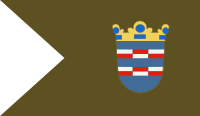
In 1618, the banner of Galicia and Lodomeria, was flown among others, during the coronation of King Ferdinand II. It depicted a coat of arms divided into five vertical stripes, that altered between a blue stripe, and the stripe divided into six fields, alternating between white and red, displayed in two rows each containing three of them. On top of it was placed a yellow (golden) crown with blue jewels. It was placed on a green background. [2] [3]
The first flag of the state had been introduced in 1809, and remained in use until 1849, its flag was divided horizontally into two equally-sized stripes, blue and red. In 1849, from the part of the territory of the Kingdom of Galicia and Lodomeria was partitioned, the Duchy of Bukovina. The duchy continued to use red and blue flag. It used said flag until 1918, when it ceased to exist. Galicia and Lodomeria adopted a new flag design, which consisted of three horizontal stripes of equal width: blue, red and yellow. [4] [5]
Such design had been used until 1890, when it was replaced by a design consisting of two horizontal stripes of equal width: red and white. Such flag remained in use until 1918, when the kingdom ceased to exist. [6] Some historians, such as Jan D. Miller, argue, that the flag had amaranth (reddish-rose) stripe instead of a red stripe. [4] However, Oesterreichisch-ungarische Wappenrolle, a coloured table of flags published in 1898, states that red and white flag was the flag of the Kingdom of Galicia and Lodomeria, while amaranth and white flag, was a flag of Polish minority within Austria-Hungary. [6]
The flag was used until 1918, when the Kingdom of Galicia and Lodomeria ceased to exist. [1] [4]

The national flag of Poland consists of two horizontal stripes of equal width, the upper one white and the lower one red. The two colours are defined in the Polish constitution as the national colours. A variant of the flag with the national coat of arms in the middle of the white fess is legally reserved for official use abroad and at sea. A similar flag with the addition of a white eagle is used as the naval ensign of Poland.

Galicia is a historical and geographic region spanning what is now southeastern Poland and western Ukraine, long part of the Polish–Lithuanian Commonwealth. It covers much of the other historic regions of Red Ruthenia and Lesser Poland.

The Kingdom of Galicia and Lodomeria, also known as Austrian Galicia or colloquially Austrian Poland, was a constituent possession of the Habsburg monarchy in the historical region of Galicia in Eastern Europe. The crownland was established in 1772. The lands were annexed from the Polish-Lithuanian Commonwealth as part of the First Partition of Poland. In 1804 it became a crownland of the newly proclaimed Austrian Empire. From 1867 it was a crownland within the Cisleithanian or Austrian half of the dual monarchy of Austria-Hungary. It maintained a degree of provincial autonomy. Its status remained unchanged until the dissolution of the monarchy in 1918.

Lodomeria is the Latinized name of Volodymyr, a Ruthenian principality also referred to as the Principality of Volhynia, which was founded by the Rurik dynasty in 987 in the western parts of Kievan Rus'. It was centered on the region of Volhynia, straddling the borders of modern-day Poland, Ukraine and Belarus. The Principality of Volodymyr arose in the course of the 12th century along with the Principality of Halych.

The Habsburg monarchy, also known as Habsburg Empire, or Habsburg Realm, was the collection of empires, kingdoms, duchies, counties and other polities that were ruled by the House of Habsburg. From the 18th century it is also referred to as the Danubian monarchy or the Austrian monarchy.
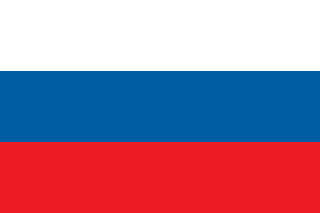
The Duchy of Carniola was an imperial estate of the Holy Roman Empire, established under Habsburg rule on the territory of the former East Frankish March of Carniola in 1364. A hereditary land of the Habsburg monarchy, it became a constituent land of the Austrian Empire in 1804 and part of the Kingdom of Illyria until 1849. A separate crown land from 1849, it was incorporated into the Cisleithanian territories of Austria-Hungary from 1867 until the state's dissolution in 1918. Its capital was German: Laibach, today Ljubljana.

The Grand Duchy of Kraków was created after the incorporation of the Free City of Cracow into Austria on November 16, 1846. From 1846 to 1918 the title, Grand Duke of Kraków, was part of the official titulary of the Emperor of Austria.

The state of Prussia had its origins in the separate lands of the Margraviate of Brandenburg and of the Duchy of Prussia. The Margraviate of Brandenburg developed from the medieval Northern March of the Holy Roman Empire, passing to the House of Hohenzollern in 1415. The Duchy of Prussia originated in 1525 when Albert of Brandenburg-Ansbach, a member of a cadet branch of the Hohenzollern house, secularized the eastern lands of the Teutonic Knights as a Polish fief. Prince-elector John Sigismund, Elector of Brandenburg, inherited the Duchy of Prussia in 1618, thus uniting Brandenburg and Prussia under one ruler in a personal union; the Elector's state became known as Brandenburg-Prussia. The Kingdom of Prussia formed when Elector Frederick III assumed the title of Frederick I, King in Prussia, on 18 January 1701.

The Austrian Partition comprises the former territories of the Polish–Lithuanian Commonwealth acquired by the Habsburg monarchy during the Partitions of Poland in the late 18th century. The three partitions were conducted jointly by the Russian Empire, the Kingdom of Prussia and Habsburg Austria, resulting in the complete elimination of the Polish Crown. Austria acquired Polish lands during the First Partition of 1772, and Third Partition of Poland in 1795. In the end, the Austrian sector encompassed the second-largest share of the Commonwealth's population after Russia; over 2.65 million people living on 128,900 km2 of land constituting the formerly south-central part of the Republic.
State Colours of the Austro-Hungarian states, displayed on their flags.

The civil flag that serves as the symbol of the state of Mecklenburg-Vorpommern, Germany, consists of five horizontal stripes, that are from the top to bottom: blue (ultramarine), white, yellow, white, and red (vermilion). It was designed by Norbert Buske and adopted on 29 January 1991. It is a combination of the historical flags of the Mecklenburg and Western Pomerania.

The flag that serves as the symbol of the historical and geographical regions of the Silesia, and Lower Silesia, and as one of the symbols of the Silesian people, is divided horizontally into two stripes: white on the top and yellow on the bottom. It originated as the flag of the Province of Silesia, used from 1882 to 1919, that later used as the flag of the Province of Lower Silesia, from 1920 to 1935. Currently, the flag is recognized symbol of the Silesian people in the state of Saxony in Germany.
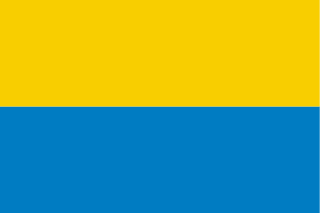
The flag that serves as the symbol of the historical and geographical region of the Upper Silesia, and as one of the symbols of the Silesian people, is divided horizontally into two stripes: yellow on the top and blue on the bottom. It originated as the flag of the Province of Upper Silesia adopted in 1920, with its colours based on the coat of arms of Upper Silesia. The flag is also popular symbol used by the Silesian Autonomy Movement.

The civil flag of the Silesian Voivodeship, Poland is triband rectangle, divided into three horizontal stripes, that are from top to bottom: blue, yellow, and blue. The blue stripes are twice the size of the yellow middle stripe. The state flag is a blue rectangle with yellow eagle placed in its centre. It was designed by Barbara Widłak, and adopted on 11 June 2001.
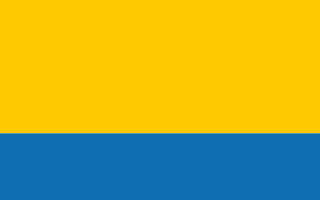
The civil flag of the Opole Voivodeship, Poland is a rectangle divided into two horizontal stripes, with yellow on the top, and blue at the bottom. The top stripe is twice the size of the bottom one.
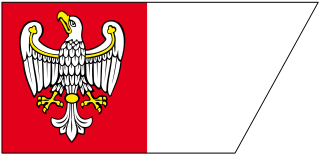
The flag of the Greater Poland Voivodeship, Poland is a trapezoid divided into red stripe on the right, and white stripe on the left, with a white eagle with yellow (golden) beak, legs, stripes on its wings, and a ring on its tail, featured in the middle of the red stripe. It was adopted in 2000.

The flag that serves as the symbol of the historical and geographical region of the Western Pomerania is divided horizontally into two stripes: light blue on the top and white on the bottom. It originated as the flag of the Province of Pomerania, Prussia, used from 1882 to 1935. Since 1996, it is officially recognized as the symbol of the historical region of Western Pomerania within Mecklenburg–Western Pomerania, Germany.

The flag that serves as the symbol of the historical and geographical region of the Mecklenburg is divided horizontally into two stripes: light blue on the top and white on the bottom. It originated as the flag of the Grand Duchy of Mecklenburg-Schwerin, adopted in 1813. Since 1996, it is officially recognized as the symbol of the historical region of Mecklenburg within Mecklenburg-Vorpommern, Germany.